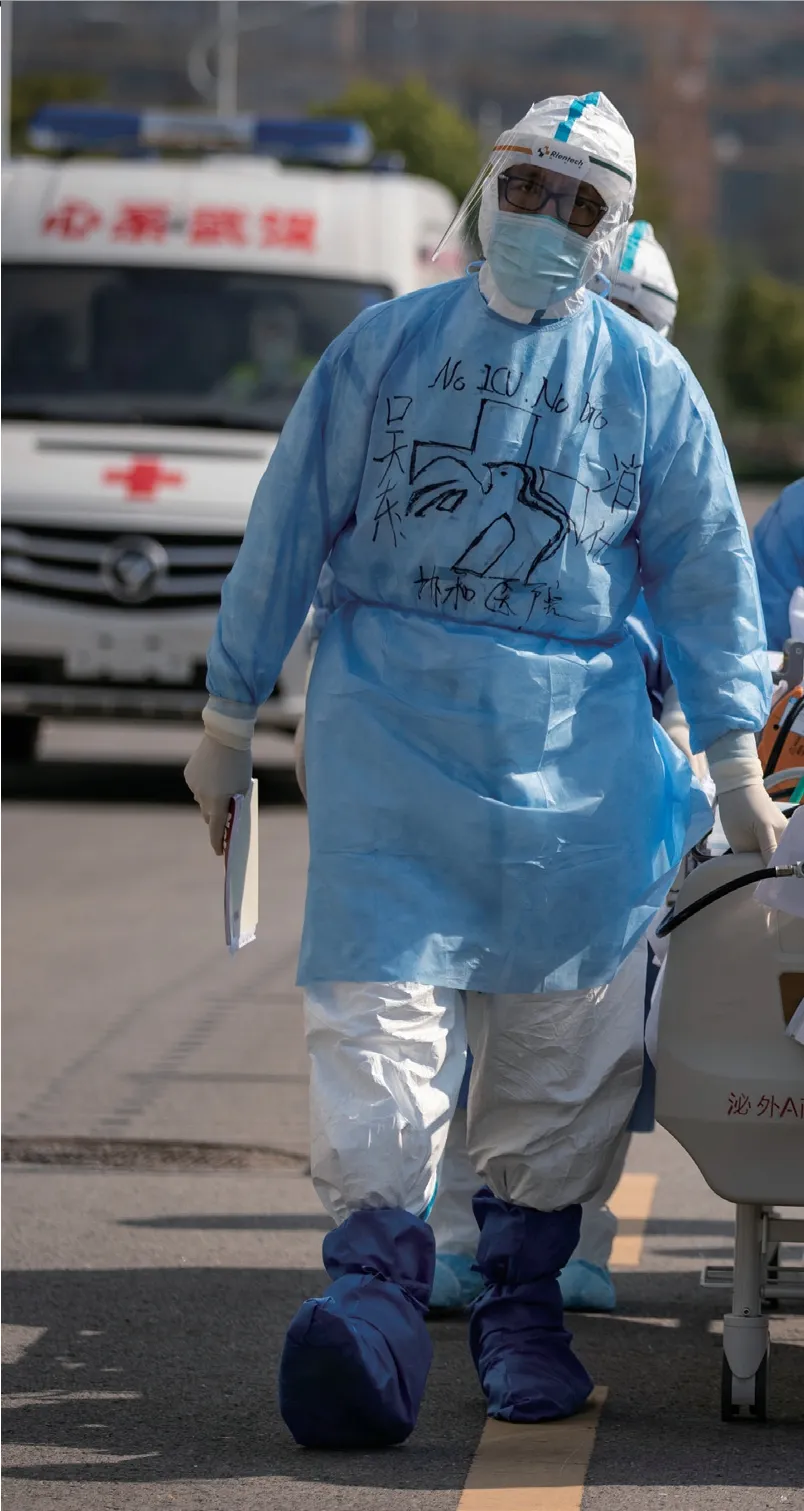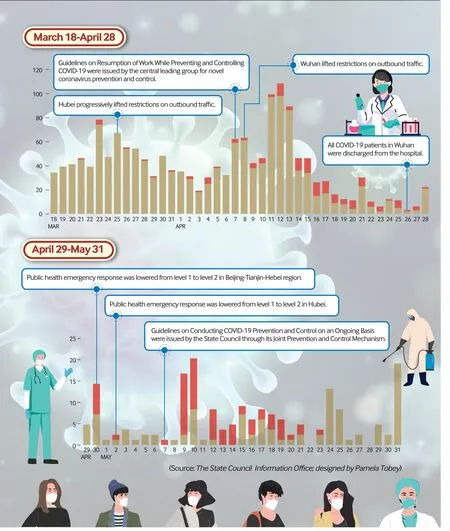Chronicle of An Epic War
Newly released white paper details China’s fight against COVID-19, and urges for global solidarity and cooperation By Lu Yan
On June 7, the State Council Information Office issued a white paper on China’s battle against the novel coronavirus disease (COVID-19). Titled Fighting COVID-19: China in Action, the white paper gives a detailed, chronological account of the government and the people’s efforts to contain the epidemic.
For now, China has successfully eliminated all channels for community transmission of COVID-19, according to the document. Accordingly, it states its main purpose as “keeping a record of China’s efforts in its own fight against the virus, sharing its experience with the rest of the world, and clarifying its ideas on the global battle.”
A test of fire
COVID-19 has spread faster and wider than any other illness since the founding of the People’s Republic of China in 1949, the white paper says. “Facing this unknown, unexpected, and devastating disease, China has launched a resolute battle to prevent and control its spread,” it states.
Making people’s lives and health its top priority, China has succeeded in putting the epidemic under control. According to the white paper, the spread of the virus was contained in a little more than a month; in around two months, the daily increase in domestic cases had fallen to single digits; and in approximately three months, a decisive victory was secured in the battle to defend Hubei Province and its capital city of Wuhan.
This achievement did not come easily for a country with a population of 1.4 billion.
The white paper divides China’s fight against the coronavirus into five stages. In the first stage from December 27, 2019 to January 19, 2020, swift actions were taken immediately after cases of pneumonia of unknown cause were identified in Wuhan. Etiological and epidemiological investigations were undertaken to stop the spread of the disease, and the epidemic situation was promptly reported. The country then launched a nationwide program of epidemic prevention and control.
The second stage, from January 20 to February 20, was the most pressing stage in China’s COVID-19 response, with rapid increase in newly confirmed cases. The government took a crucial step to stem the spread of the virus, closing outbound traffic from Wuhan. It marked the beginning of an all-out battle to protect Wuhan and Hubei.
The second stage also saw initial progress in curbing the spread of the virus, as emergency response mechanisms were set up and resources from the entire country were mobilized to assist Hubei and Wuhan. Protocols on the diagnosis and treatment, as well as the prevention and control of COVID-19 were issued, and were constantly updated.
These coordinated efforts saw marked results during the second stage. According to the white paper, on February 19, newly recovered and discharged patients in Wuhan outnumbered newly confirmed cases for the first time since the outbreak began.
During the third stage that lasted from February 21 to March 17, the rapid spread of the virus had been contained, both in Wuhan and in the rest of Hubei, and the situation in other parts of the Chinese mainland began to stabilize. Since mid-March, the daily number of new cases across the country remained in single digits. At a national level, the epidemic peak had passed, with the steady decline in new cases indicating the epidemic was under control.
在AP3综合异常区发现有三条银矿体,规模不大, Ag品位68.35×10-6—159.0×10-6,矿体宽1.0-3.0 m。
In light of the situation, the Communist Party of China (CPC) Central Committee made the decision to integrate epidemic control with economic and social development in order to facilitate an orderly return to normal work and daily life.

The fourth stage, from March 18 to April 28, witnessed an initial victory in the nationwide battle against the coronavirus, with China halting the spread of COVID-19 on the mainland. Restrictions on outbound traffic from Wuhan and Hubei were lifted, and all COVID-19 patients in Wuhan hospitals were discharged on April 26.
However, sporadic cases continued to emerge, and additional infections were caused by inbound arrivals carrying the virus as it continued to spread overseas during this period. The CPC Central Committee adopted a targeted approach to prevent the virus from entering the country and prevent its domestic resurgence.
At a meeting of the Standing Committee of the Political Bureau of the CPC Central Committee, Xi Jinping, General Secretary of CPC Central Committee and Chinese President, warned against any relaxation of efforts to stop inbound cases or forestall domestic resurgence of cases, saying control at land and sea points of entry should be tightened to minimize domestic cases caused by inbound arrivals carrying the virus.

Medical workers transfer a COVID-19 patient to the Sino-French New City Branch of Tongji Hospital in Wuhan, Hubei Province in central China, on April 12
Since April 29, the national endeavor has entered its fifth stage. Positive momentum in COVID-19 control has been established, and nationwide virus control is now being conducted on an ongoing basis.
“China’s fight against the COVID-19 epidemic is a shared memory of the 1.4 billion Chinese people, and will always be remembered by the Chinese people,” said Xu Lin, director of the State Council Information Office, at a press conference during which the white paper was released.
People first
In the face of the virus, China has put the interests of its people first. “Nothing is more precious than people’s lives,” the white paper states. Manpower and resources of the whole nation have been rapidly mobilized to fight the epidemic and protect the lives and health of its people.
Medical workers employed proactive, science-based, and flexible methods of treatment and did everything possible to treat each and every patient, from an infant only 30 hours old to a centenarian. “The goal was to save every single patient, whatever the cost,” the white paper states.
One example featured in the white paper was that of a 70-year-old patient who was saved by more than 10 medical workers over a period of several weeks, at the cost of nearly 1.5 million yuan ($212,400), which was fully covered by the government.
In addition, Chinese citizens overseas also received care. Medical expert teams and work groups were dispatched overseas and telemedicine service platforms were established, providing scientific and professional guidance on COVID-19 prevention and control for Chinese citizens in other countries.
Chinese embassies and consulates abroad disseminated information on COVID-19 prevention and self-protection through all channels, and have provided more than 1 million health kits to overseas Chinese students.
In an editorial, Sustaining Containment of COVID-19 in China,The Lancetstated: “China’s success has come with huge social and economic costs, and China must make difficult decisions to achieve an optimal balance between health and economic protection.”
Global community of health
Preventing and controlling the spread of the virus has become a fight that will shape the future of the human race. The white paper conveys China’s hope that all countries make choices that prioritize the shared interests of humanity and the wellbeing of our future generations.
In upholding the vision of a global community and shared future, countries should support each other and join hands to contain the spread of the virus, and protect the health and wellbeing of people across the globe.
China has been carrying out exchanges and cooperation with the international community from the outset. The CPC has issued a joint appeal with 240 political parties in more than 110 countries, calling on all stakeholders to put people’s lives and health first, uphold the vision of a global community of shared future, and pull together to combat the virus.
China has not only shared information and experience on virus prevention and control with the international community, but also provided humanitarian assistance, medical aid and protective materials to other countries.
Xi has promoted international cooperation and put forward a series of major measures that China would take in supporting the global fight, including $2 billion of international assistance over two years, which he announced at the opening of the 73rd World Health Assembly on May 18.
In the meantime, China has received support and assistance from the international community in the form of emergency medical supplies, donations and loans.
The Chinese nation never forgets the help and generosity it receives, and always reciprocates with the same goodwill, the white paper reiterates.
As the coronavirus continues to spread and cause devastation across the globe, both the fight to rein in the virus and the endeavor to fend off a deepening global recession call for the international community to stand in unity and engage in cooperation.
China calls on all countries to act promptly, demonstrate solidarity, strengthen cooperation on all fronts, and fight the pandemic together. The white paper states, “Solidarity and cooperation are the most powerful weapons available to the international community in the war against the pandemic. What we do today determines how we will fare in the future.”



